状语从句重点难点归纳
- 格式:pptx
- 大小:6.47 MB
- 文档页数:51
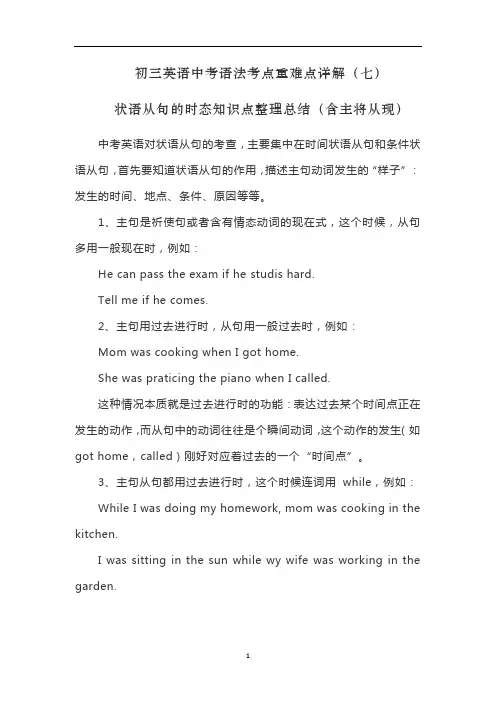
初三英语中考语法考点重难点详解(七)状语从句的时态知识点整理总结(含主将从现)中考英语对状语从句的考查,主要集中在时间状语从句和条件状语从句,首先要知道状语从句的作用,描述主句动词发生的“样子”:发生的时间、地点、条件、原因等等。
1、主句是祈使句或者含有情态动词的现在式,这个时候,从句多用一般现在时,例如:He can pass the exam if he studis hard.Tell me if he comes.2、主句用过去进行时,从句用一般过去时,例如:Mom was cooking when I got home.She was praticing the piano when I called.这种情况本质就是过去进行时的功能:表达过去某个时间点正在发生的动作,而从句中的动词往往是个瞬间动词,这个动作的发生(如got home,called)刚好对应着过去的一个“时间点”。
3、主句从句都用过去进行时,这个时候连词用while,例如:While I was doing my homework, mom was cooking in the kitchen.I was sitting in the sun while wy wife was working in the garden.这种情况其实是考试连词while的含义:在……的过程中,这样从句的动词就需要一个“延续性”动词,才能和while 配合完美。
4、关于条件句的用法,是出题人最喜欢采用的If he comes, give him the picture.(主句是祈使句,天剑局是一般现在时)If we try our best, we'll get good grades.主将从现是一般原则,但是要注意也有很多不是主将从现的主从句配合。
补充知识点:“主将从现”首先我们知道一个句子的成分包含,“主谓宾定状补”,那么在句中作状语的从句称为状语从句。
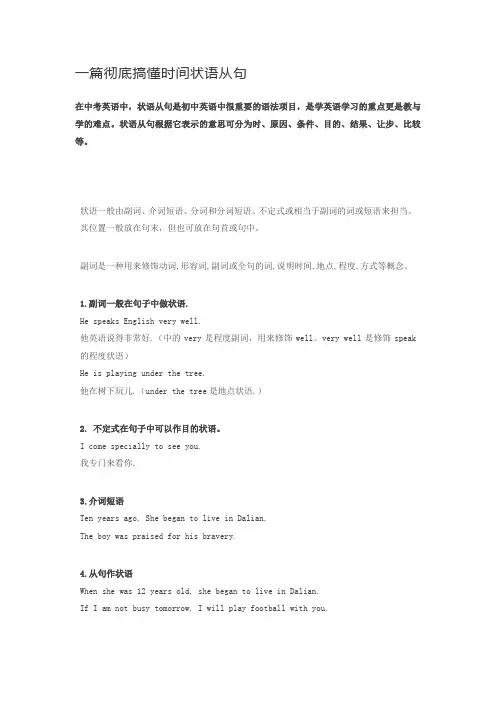
一篇彻底搞懂时间状语从句在中考英语中,状语从句是初中英语中很重要的语法项目,是学英语学习的重点更是教与学的难点。
状语从句根据它表示的意思可分为时、原因、条件、目的、结果、让步、比较等。
狀语一般由副词、介词短语、分词和分词短语、不定式或相当于副词的词或短语来担当。
其位置一般放在句末,但也可放在句首或句中。
副词是一种用来修饰动词,形容词,副词或全句的词,说明时间,地点,程度,方式等概念。
1.副词一般在句子中做状语.He speaks English very well.他英语说得非常好.(中的very是程度副词,用来修饰well。
very well是修饰speak 的程度状语)He is playing under the tree.他在树下玩儿.(under the tree是地点状语.)2. 不定式在句子中可以作目的状语。
I come specially to see you.我专门来看你.3.介词短语Ten years ago, She began to live in Dalian.The boy was praised for his bravery.4.从句作状语When she was 12 years old, she began to live in Dalian.If I am not busy tomorrow, I will play football with you.5.分词作状语Having had a quarrel with his wife, he left home in a bad temper.Inhibited in one direction, it now seems that the Mississippi is about to take another.中考主要考查引导状语从句的连词、从句时态等方面。
重点考查时间状语从句、条件状语从句、结果状语从句和比较状语从句。
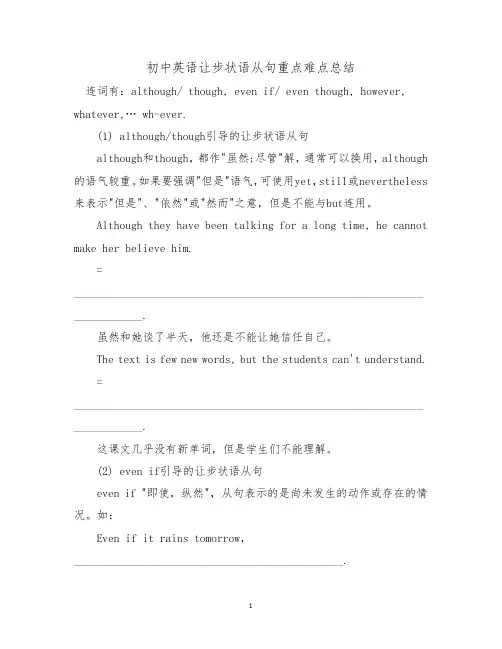
初中英语让步状语从句重点难点总结连词有:although/ though, even if/ even though, however, whatever,… wh-ever.(1) although/though引导的让步状语从句although和though,都作"虽然;尽管"解,通常可以换用,although 的语气较重。
如果要强调"但是"语气,可使用yet,still或nevertheless 来表示"但是"、"依然"或"然而"之意,但是不能与but连用。
Although they have been talking for a long time, he cannot make her believe him.=_____________________________________________________________ ____________.虽然和她谈了半天,他还是不能让她信任自己。
The text is few new words, but the students can't understand.=_____________________________________________________________ ____________.这课文几乎没有新单词,但是学生们不能理解。
(2) even if引导的让步状语从句even if "即使,纵然",从句表示的是尚未发生的动作或存在的情况。
如:Even if it rains tomorrow,_______________________________________________.即使明天下雨,我们也不改变计划。
Even if I failed again, I will not _____________ the experiment.即使我再次失败,我也不会放弃实验。

Unit6 An old man tried to move the mountains.一、语法难点本单元的语法重点是状语从句,主要讲述以下三种状语从句。
1.unless引导条件状语从句unless = if … not “除非,若不”They will go tomorrow unless it rains.= They will go tomorrow if it doesn’t rains.2.as soon as引导时间状语从句。
“一……就”He will come and see you as soon as he can.3. so.......that引导结果状语从句句型1“主语+谓语+so+形容词/副词+that从句”The wind was so strong that we could hardly move forward.句型2:so +形容词+ a/an + 单数名词+ that从句It was so hot a day that they all went swimming.句型3. so + many/ few + 复数名词+ that从句He has so few friends that he often feels lonely.句型4:so +much/ little + 不可数名词+ that 从句I had so little money that I couldn’t buy a pen.二、重点短语及词组1. work on doing sth. 致力于做某2. assoon as ...... 一……就…....3. once upon a time 从前4. continue to do sth. 继续做某事5. make sth. happen 使某事发生6.try to do sth. 试图做某事7. the journey to sp. ......之旅8. tell the/a story 讲故事9. put on 穿上10. a little bit 有点儿11. keep doing sth. 坚持做某事12. give up 放弃13. instead of 代替;反而14. turn .. . into 变成15. get married 结婚16. the main character 主要人物;主人公17. at other times 在另外一些时候18. be able to 能;会19. come out (书、电影等)出版20. become interested in. 对……感兴趣21. walk to the other side 走到另一边去22. a fairy tale 一个神话故事23. the rest of the story 故事的其余部分24. leave sb. to do sth. 让某人做某事25. make a plan to do sth. 筹划/计划做某事26. go to sleep 去睡觉27. lead sb. to sp. 把某人领到某地28. get lost 迷路29. change one’s plan 改变计划30. tell sb. to do sth. 叫某人做某事31. in the moonlight 在月光下32. find one’ s way home 找到某人回家的路33. the next day 第二天34. send sb. to sp. 派某人去某地35. so... that 如此… …以至于…三.知识点讲解Section A1.How does the story begin? 故事是怎么发生的?【解析】begin →began→begun v 开始→beginning n 开始at the beginning of 在……开始【拓展】begin to do sth/ doing sth 开始做某事2. A man told yu Gong that he could never do it.【解析1】tell sb. that 告诉某人【辨析】speak/talk/say/tell▲say“讲,说”,强调说话内容。
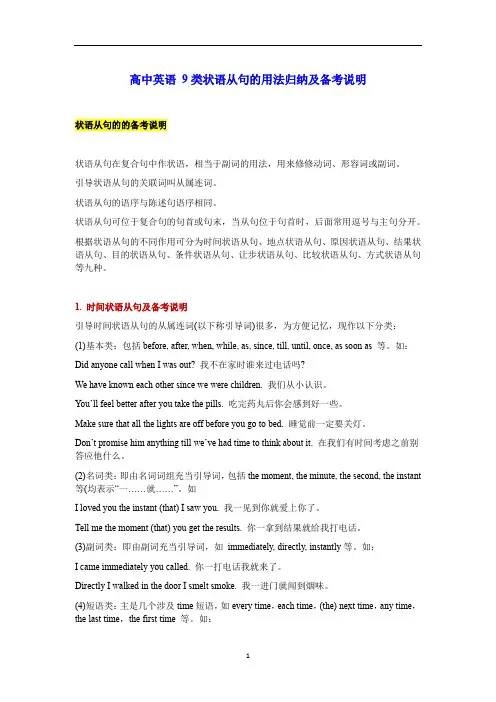
高中英语9类状语从句的用法归纳及备考说明状语从句的的备考说明状语从句在复合句中作状语,相当于副词的用法,用来修修动词、形容词或副词。
引导状语从句的关联词叫从属连词。
状语从句的语序与陈述句语序相同。
状语从句可位于复合句的句首或句末,当从句位于句首时,后面常用逗号与主句分开。
根据状语从句的不同作用可分为时间状语从句、地点状语从句、原因状语从句、结果状语从句、目的状语从句、条件状语从句、让步状语从句、比较状语从句、方式状语从句等九种。
1. 时间状语从句及备考说明引导时间状语从句的从属连词(以下称引导词)很多,为方便记忆,现作以下分类:(1)基本类:包括before, after, when, while, as, since, till, until, once, as soon as 等。
如:Did anyone call when I was out? 我不在家时谁来过电话吗?We have known each other since we were children. 我们从小认识。
You’ll feel better after you take the pills. 吃完药丸后你会感到好一些。
Make sure that all the lights are off before you go to bed. 睡觉前一定要关灯。
Don’t promise him anything till we’ve had time to think about it. 在我们有时间考虑之前别答应他什么。
(2)名词类:即由名词词组充当引导词,包括the moment, the minute, the second, the instant 等(均表示“一……就……”。
如I loved you the instant (that) I saw you. 我一见到你就爱上你了。
Tell me the moment (that) you get the results. 你一拿到结果就给我打电话。
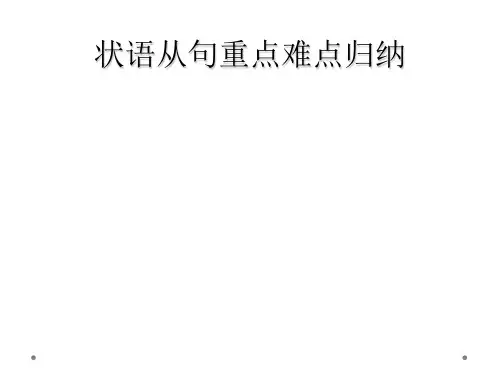
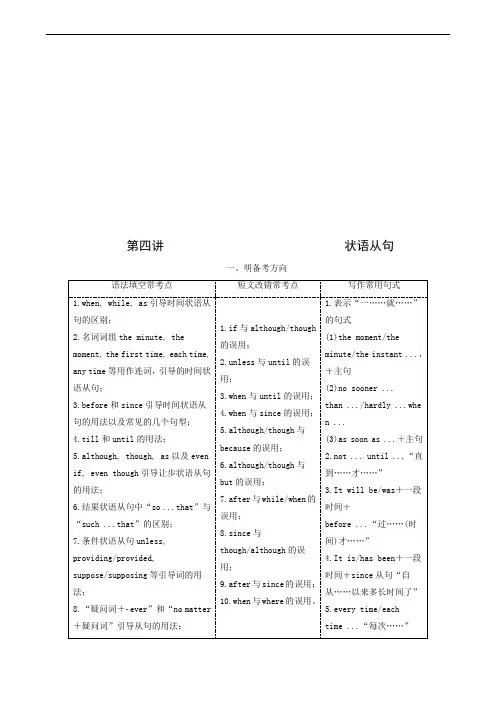
第四讲状语从句一、明备考方向二、攻重点难点(一)引导时间状语从句的从属连词及重点句式1.引导时间状语从句的从属连词有:when, whenever, while, as, before, after, since, till/until, as soon as, no sooner ...than, hardly/scarcely ...when, immediately, instantly, the moment, every/each time等。
2.在掌握时间状语从句时,要注意以下几个重点句式:(1)not ...until ...“直到……才……”(2)It+will be/was+一段时间+before ... “过……(时间)才……”(3)It+is/has been+一段时间+since ... “自从……以来多长时间了”(4)It+was+not long before ...“不久……就……”(5)No sooner+had+主语+过去分词 ...than ...(正常语序:主语+had no sooner+过去分词+than ...) “一……就……”(6)Hardly/Scarcely+had+主语+过去分词 ...when ... (正常语序:主语+had hardly/scarcely +过去分词+when ...)“一……就……”When I lived there, I used to go to the seashore on Sundays.我住在那里时,星期天常到海滨去。
Please don't talk so loud while others are working.在别人工作的时候,请别这么大声音说话。
It was some time before I realized the truth.过了很长一段时间我才悟出真相。
He had no sooner finished his speech than the students started cheering.=No sooner had he finished his speech than the students started cheering.他刚完成演讲学生们就开始欢呼起来。
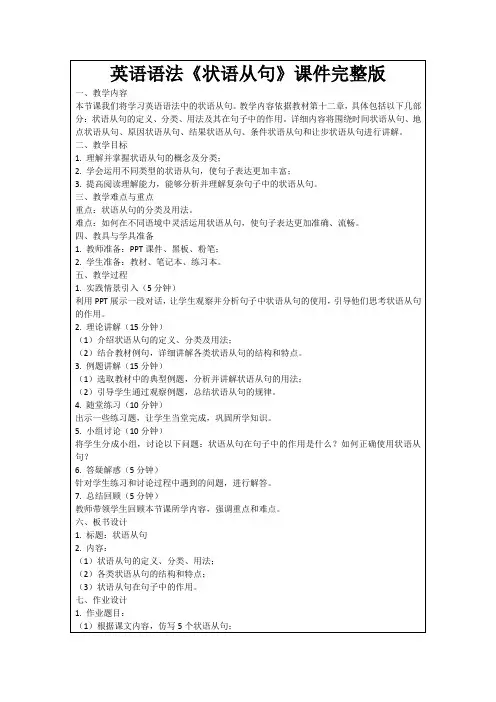
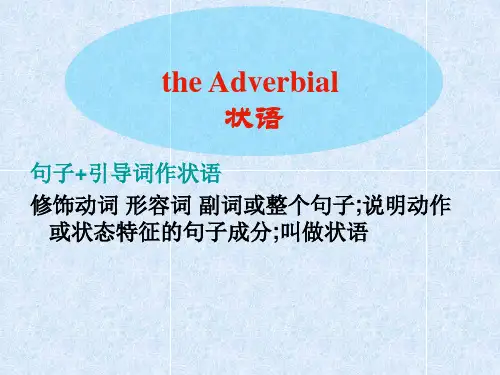
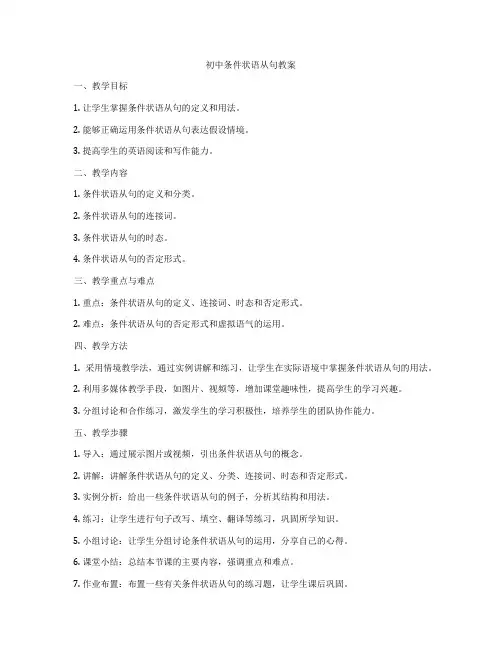
初中条件状语从句教案一、教学目标1. 让学生掌握条件状语从句的定义和用法。
2. 能够正确运用条件状语从句表达假设情境。
3. 提高学生的英语阅读和写作能力。
二、教学内容1. 条件状语从句的定义和分类。
2. 条件状语从句的连接词。
3. 条件状语从句的时态。
4. 条件状语从句的否定形式。
三、教学重点与难点1. 重点:条件状语从句的定义、连接词、时态和否定形式。
2. 难点:条件状语从句的否定形式和虚拟语气的运用。
四、教学方法1. 采用情境教学法,通过实例讲解和练习,让学生在实际语境中掌握条件状语从句的用法。
2. 利用多媒体教学手段,如图片、视频等,增加课堂趣味性,提高学生的学习兴趣。
3. 分组讨论和合作练习,激发学生的学习积极性,培养学生的团队协作能力。
五、教学步骤1. 导入:通过展示图片或视频,引出条件状语从句的概念。
2. 讲解:讲解条件状语从句的定义、分类、连接词、时态和否定形式。
3. 实例分析:给出一些条件状语从句的例子,分析其结构和用法。
4. 练习:让学生进行句子改写、填空、翻译等练习,巩固所学知识。
5. 小组讨论:让学生分组讨论条件状语从句的运用,分享自己的心得。
6. 课堂小结:总结本节课的主要内容,强调重点和难点。
7. 作业布置:布置一些有关条件状语从句的练习题,让学生课后巩固。
六、教学反思通过本节课的教学,观察学生的学习效果,对教学方法和内容进行调整和改进,以提高学生的英语水平。
同时,关注学生的学习兴趣和积极性,创设轻松愉快的学习氛围,使学生在愉悦中学习英语。
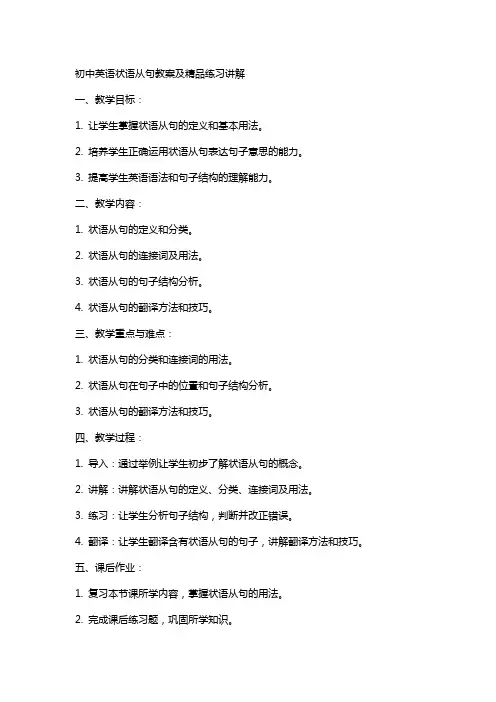
初中英语状语从句教案及精品练习讲解一、教学目标:1. 让学生掌握状语从句的定义和基本用法。
2. 培养学生正确运用状语从句表达句子意思的能力。
3. 提高学生英语语法和句子结构的理解能力。
二、教学内容:1. 状语从句的定义和分类。
2. 状语从句的连接词及用法。
3. 状语从句的句子结构分析。
4. 状语从句的翻译方法和技巧。
三、教学重点与难点:1. 状语从句的分类和连接词的用法。
2. 状语从句在句子中的位置和句子结构分析。
3. 状语从句的翻译方法和技巧。
四、教学过程:1. 导入:通过举例让学生初步了解状语从句的概念。
2. 讲解:讲解状语从句的定义、分类、连接词及用法。
3. 练习:让学生分析句子结构,判断并改正错误。
4. 翻译:让学生翻译含有状语从句的句子,讲解翻译方法和技巧。
五、课后作业:1. 复习本节课所学内容,掌握状语从句的用法。
2. 完成课后练习题,巩固所学知识。
3. 收集含有状语从句的句子,进行翻译和分析。
注意事项:1. 教学过程中要注意举例生动、贴近生活,激发学生的学习兴趣。
2. 针对不同程度的学生,适当调整教学难度,确保教学质量。
3. 注重培养学生的语法分析和运用能力,提高他们的英语水平。
六、教学策略与方法:1. 采用情景教学法,通过设定真实的生活场景,让学生在实际语境中学习和运用状语从句。
2. 使用任务型教学法,设计各种练习任务,让学生在完成任务的过程中掌握状语从句的用法。
3. 采用合作学习法,鼓励学生分组讨论,共同分析句子结构和翻译方法。
4. 运用多媒体教学手段,如PPT、视频等,丰富教学内容,提高学生的学习兴趣。
七、教学评价:1. 课堂表现:观察学生在课堂上的参与程度、发言情况和语法运用准确性。
2. 课后作业:检查学生完成作业的质量,包括语法、句子结构和翻译等方面。
3. 单元测试:定期进行单元测试,评估学生对状语从句知识的掌握程度。
4. 学生互评:鼓励学生相互评价,共同提高英语水平。
八、教学计划:1. 第一周:讲解状语从句的定义和分类。
高中英语状语从句以及练习状语从句1. 定义:在复合句中由从句表示的状语称作状语从句,它可以用来修饰谓语(包括非谓语动词)、定语或状语,或是整个句子。
2. 考点:(1) 状语从句连接词的选用(2) 状语从句的时态3. 分类:(9种)时间状语从句,地点状语从句,原因状语从句,条件状语从句,让步状语从句,结果状语从句,目的状语从句,方式状语从句,比较状语从句4. 重点,难点,考点A.时间状语从句:(1)表示同时性,即主从句的谓语动作同时发生或几乎同时发生。
其连词有:when (当……的时候), while(当……的时候), as(当……的时候), once(一旦……)as soon as(一……就……), the time(当……的时刻), the moment(当……的时刻), by the time(到……时候为止), next time(下次),the first time(第一次……的时候),the last time(上次……的时候),immediately(一……就……),instantly(一……就……),directly(一……就……)以下关联词引起的句子中,前面常用过去完成时,后面用一般过去时hardly /scarcely…when…= no sooner…than…(一……就……)Strike while the iron is hot.趁热打铁。
While I am washing the floor, you can be cleaning the windows.我洗地板的时候,你可以擦窗户。
As / When I came home, I met an old schoolmate of mine.我回家的时候遇到了我的一位老同学。
I’ll r ing you up as soon as I get an answer from him.我一有他的答复就给你打电话。
Once you see him, you will never forget him. 你一旦见过他,就不会忘了他的。
中考英语专题复习:状语从句(带答案)学员姓名:学科教师:年级:辅导科目:英语授课日期××年××月××日时间 A / B / C / D / E / F段主题状语从句教学内容(本次课的重点、难点以及达到怎样的情感目标)1.了解状语从句的基本类型及所表达的概念;2.掌握时间和让步状语从句中主将从现的特殊用法;3. 能在写作表达中灵活运用状语从句。
教学建议:由于此部分知识点学生已经学过,建议老师采取优先选择的方式让学生各自负责一个知识点进行讲解,其他学生进行提问。
老师在过程中进行补充和总结并对重要的考点进行强调。
I.状语从句学习一、基本概念:状语从句指的是在主从句中作状语的从句,修饰主句中的动词、形容词或副词等。
状语放在主句之前时,常用逗号分开;若放在主句之后,一般不用逗号。
要点:连词+从句If he works hard, he will surely succeed.When Susan goes to town, she will visit her grandma.Mary didn't go shopping because I advised her not to.Though we are all different, we need never be separate.I will come to see you as soon as you arrive at the airport.二、状语从句分类复习1.when, before, after, as soon as, until…时间状语从句I will go to the cinema as soon as I finish my homework. When I grow up, I will join the army. He didn ’t go to bed until his parents retuned. Children will be taller and taller until they reach 25.练习: Tim didn’t hav e dinner ________ he finished watching the cartoon.A. whileB. becauseC. untilD. since2、We will stay at home if it rains tomorrow. He won’t come here unless he is invited.练习:I don't know if my uncle will come. ________ he comes, I will be very happy.A. BecauseB. WhereverC. IfD. Although3 .He failed the exam because he didn’t work hard. 练习:He didn’t come ________ he was ill.A. becauseB. whereverC. ifD. although4We still worked in the field although / though it was raining hard.练习: _______ many children like sugar, I think they had better try not to eat it too often.A. BecauseB. WhenC. AlthoughD. If5.It’s so hot that nobody wants to go out. 练习: ---Did you catch what the teacher said?---No. She spoke so fast _______ I couldn’t hear her very clearly. A. althoughB. thatC. whenD. sinceif (如果)、unless (除非)条件状语从句because (因为)原因状语从句although 或though (虽然;尽管)让步状语从句so that(结果是),“so…that”(如此…以至于) 结果状语从句★主将从现★主将从现I. Choose the best answer.1.—You study ______ hard ______ you’re sure to pass the exam.—Thank you for saying so.A. enough; toB. as; asC. so; thatD. such…that2.______ hamburgers are junk food, many children like them.A. IfB. UnlessC. BecauseD. Although3.—During the Spring Festival, a lot of people take the bullet train(动车组) home ____ it is expensive.—Yes, but it’s really fast.A. soB. asC. becauseD. though4.Maria didn’t catch the last bus, ______ she had to walk home.A. becauseB. soC. butD. though5.I ______ believe it _______ I see it with my own eyes.A. won’t; andB. will; butC. will; untilD. won’t; until6.—I don’t know when _______ tomorrow?—I will call you as soon as he _______.A. will he come; arrivesB. he will come; arrivesC. he will come; will arriveD. will he come; will arrive7.Yesterday evening, I _______ along the street when I suddenly met my maths teacher.A. walkB. walkedC. was walkingD. am walking8.China has offered much help to Japan since it ______ by the earthquake and tsunami(海啸).A. hitsB. is hitC. was hitD. will be hit9.—Do you know if he________ to play football with us?—I think he will come if he _________ free tomorrow.A. comes; isB. comes; will beC. will come; isD. will come; will beII.Reading教学建议:1.让学生带着后面的问题在限定的时间6分钟内完成本篇文章的阅读;2.读完提问学生简单复述故事;3.提问学生根据语境猜测黑体部分单词的含义。
状语从句教案教案标题:状语从句教案一、教学目标:1. 知识目标:学生能够理解和区分状语从句及其分类,并掌握它们在句子中的正确用法。
2. 能力目标:学生能够正确运用状语从句来丰富和改变句子的意思。
3. 情感目标:通过学习状语从句,培养学生对语法知识的兴趣,提高他们的语言表达能力。
二、教学重点:1. 理解和分辨状语从句及其分类。
2. 掌握状语从句的常见引导词和句型。
3. 运用状语从句来改变句子结构和运用范围。
三、教学难点:1. 区分状语从句的不同类型。
2. 理解状语从句与主句的逻辑关系。
四、教学方法:1. 提问法:通过提问,引导学生思考状语从句的不同种类及其用法。
2. 归纳法:通过让学生总结规律,形成对状语从句的整体概念。
3. 练习法:通过一些练习题帮助学生巩固状语从句的使用。
五、教学过程:1. 导入:通过提问复习学生对从属连词的理解,例如:“when”和“where”这样的词在句子中有什么作用?2. 呈现:向学生介绍状语从句的定义和作用,以及主要的引导词,如:"when","where","if"等。
3. 教学:详细讲解不同类型的状语从句,并分别给出例句和解释,如时间状语从句、地点状语从句、条件状语从句等。
4. 练习:让学生根据给定的句子,判断下划线部分是哪种类型的状语从句,并改写句子,如:"I will call you when I arrive home." → "When I arrive home, I will call you."5. 巩固:让学生在小组中进行练习,编写句子包含状语从句,并与同伴分享。
6. 拓展:给学生一些拓展练习,包括使用不同类型的状语从句来改写句子或填空练习。
7. 总结:让学生总结本堂课所学内容,包括状语从句的定义、特点、分类和使用方法。
8. 作业:布置相关的练习题,巩固学生对状语从句的理解和运用。
状语从句一、时间状语从句要点: 时间状语从句,由以下连词引导:When,while,as,after,before,as soon as,since,till /until,by the time在时间状语从句中,要注意时态一致。
一般情况下主句是将来时的时候,从句要用一般现在时(主将从现)。
1. whenMozart started writing music when he was four years old.2. whileHe visited a lot of places while he was traveling.3. asHe smiled as he stood up.as/when/while的辨析as、when、while都表示主、从句动作同时发生(均为当......的时候的意思),三者差异如下:① as 表示“一边, 一边"的意思,强调两个动作同时进行,并表示对比① when 1. 还可以表示从句动词的动作在主句动词的动作"之前"或"之后"发生。
2. when=and then; at that moment (正在那个时候)① while 1. 用于时间较长时(while 后常跟进行时)2. 强调两个动作同时进行,并表示对比时有时这三个连词可以互换,有时不可以。
When I had read the article, he called me.When I got to the cinema, the film had begun.She thought I was talking about her daughter, while, in fact, I was talking about my daughter. While the alien was buying a souvenir, the girl called the police.Mother was worried because little Alice was ill, especially as father was away.4. afterHe left the classroom after he had finished his homework the other day.5. beforeMr. Brown had worked in a bank for a year before he came here.6. as soon asWe began to work as soon as we got there.I will write to you as soon as I get home. 我一到家就给你写信。
状语从句状语从句是一个句子充当另一个句子的状语,表示主句动作发生的时间、条件、原因、方式、结果、目的等等。
状语从句是历年高考题的重点、难点。
命题一般是考查学生连词的掌握情况,根据两个句子的意思,判断两个句子之间的逻辑关系,选择合适的连词。
常见的状语从句有九大类。
一、时间状语从句1.when, as与while表示时间when既可表示“一段时间”(与持续性动词连用),又可表示“时间点”(与瞬间动词连用);when可作并列连词,意为“这(那)时”。
while只表示“一段时间”,只与持续性动词连用,while可表示对比转折,有“然而”之意。
虽然during 与while 意思很相近,但是during是介词,不能引导从句。
as用法同when相似,但侧重主句和从句动作发生的同时性,可译作“随着”,“一边……一边……”。
I fell asleep when/as/while he was doing his exercises.When/As he arrived in Shanghai, she met him at the station.I was about to go out when it began to rain.I like tea while she likes coffee.As spring warms the earth, all flowers begin to bloom.当when意思是正当……时候(and at that moment)时,when只能跟在前一分句之后。
He was about to go to bed when the doorbel rang.有时when表示虽然,尽管的含义,相当于although或since。
He walks when he might take a taxi.尽管可以打的,但他还是步行。
②在下列情况下,三者彼此之间不能替换使用:a.as更强调同一时间或紧接的一前一后或伴随着的变化。